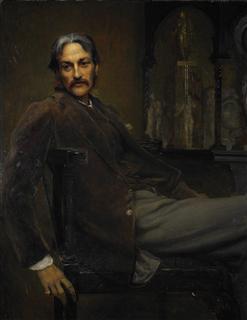安德鲁·朗格
安德鲁·朗格的作品
- 《红皮童话书》The Red Fairy Book
- 《安格林素描》Angling Sketches
- 《奥加西恩和尼古里特》Aucassin and Nicolete
- 《班和阿利埃尔·班》Ban and Arriere Ban
- 《书籍和书人》Books and Bookmen
- 《帕那色斯草》Grass of Parnassus
- 《关于文学》Letters on Literature
- 《致已故作者》Letters to dead authors
- 《特罗伊的传说》Tales of Troy
- 《图书馆》The Library
- 《古法兰西民抒情歌与诗集》Ballads and Lyrics of Old France with Other Poems
- 《苏格兰简史》A Short History of Scotland
- 《一千零一夜》The Arabian Nights
作者介绍

Andrew Lang
中文名:安德鲁·朗格
Andrew Lang (31 March 1844, Selkirk – 20 July 1912, Banchory, Kincardineshire) was a prolific Scots man of letters. He was a poet, novelist, and literary critic, and contributor to anthropology. He now is best known as one of the most important collectors of folk and fairy tales.
The Andrew Lang lectures at the University of St Andrews are named for him.
Biography
Lang was the eldest of the eight children of John Lang, town clerk of Selkirk, and his wife, Jane Plenderleath Sellar, daughter of Patrick Sellar, factor to the first duke of Sutherland. On 17 April 1875 he married Leonora Blanche Alleyne, youngest daughter of C. T. Alleyne of Clifton and Barbados.
He was educated at Selkirk grammar school, and at the Edinburgh Academy, St Andrews University and at Balliol College, Oxford, where he took a first class in the final classical schools in 1868, becoming a fellow and subsequently honorary fellow of Merton College. As a journalist, poet, critic and historian, he soon made a reputation as one of the most able and versatile writers of the day.
He died of angina pectoris at the Tor-na-Coille Hotel in Banchory, survived by his wife. He was buried in the cathedral precincts at St Andrews.
Professions
Folklore and anthropology
"Rumpelstiltskin," from Lang's Fairy Tales.Lang is now chiefly known for his publications on folklore, mythology, and religion. The earliest of his publications is Custom and Myth (1884). In Myth, Ritual and Religion (1887) he explained the "irrational" elements of mythology as survivals from more primitive forms. Lang's Making of Religion was heavily influenced by the 18th century idea of the "noble savage": in it, he maintained the existence of high spiritual ideas among so-called "savage" races, drawing parallels with the contemporary interest in occult phenomena in England. His Blue Fairy Book (1889) was a beautifully produced and illustrated edition of fairy tales that has become a classic. This was followed by many other collections of fairy tales, collectively known as Andrew Lang's Fairy Books. Lang examined the origins of totemism in Social Origins (1903).
Psychical research
Lang was one of the founders of "Psychical Research" and his other writings on anthropology include The Book of Dreams and Ghosts (1897), Magic and Religion (1901) and The Secret of the Totem (1905). He served as President of the Society for Psychical Research in 1911.
Classical scholarship
He collaborated with S.H. Butcher in a prose translation (1879) of Homer's Odyssey, and with E. Myers and Walter Leaf in a prose version (1883) of the Iliad, both still noted for their archaic but attractive style. He was a Homeric scholar of conservative views. Other works include Homer And The Study Of Greek found in Essays In Little (1891), Homer and the Epic (1893); a prose translation of The Homeric Hymns (1899), with literary and mythological essays in which he draws parallels between Greek myths and other mythologies; and Homer and his Age (1906).
Historian
Lang's writings on Scottish history are characterised by a scholarly care for detail, a piquant literary style, and a gift for disentangling complicated questions. The Mystery of Mary Stuart (1901) was a consideration of the fresh light thrown on Mary Queen of Scots by the Lennox manuscripts in the University Library, Cambridge, approving of her and criticising her accusers.
He also wrote monographs on The Portraits and Jewels of Mary Stuart (1906) and James VI and the Gowrie Mystery (1902). The somewhat unfavourable view of John Knox presented in his book John Knox and the Reformation (1905) aroused considerable controversy. He gave new information about the continental career of the Young Pretender in Pickle the Spy (1897), an account of Alestair Ruadh MacDonnell, whom he identified with Pickle, a notorious Hanoverian spy. This was followed by The Companions of Pickle (1898) and a monograph on Prince Charles Edward (1900). In 1900 he began a History of Scotland from the Roman Occupation (1900). The Valet's Tragedy (1903), which takes its title from an essay on Dumas's Man in the Iron Mask, collects twelve papers on historical mysteries, and A Monk of Fife (1896) is a fictitious narrative purporting to be written by a young Scot in France in 1429-1431.
Andrew Lang at work. Other writings
Lang's earliest publication was a volume of metrical experiments, The Ballads and Lyrics of Old France (1872), and this was followed at intervals by other volumes of dainty verse, Ballades in Blue China (1880, enlarged edition, 1888), Ballads and Verses Vain (1884), selected by Mr Austin Dobson; Rhymes à la Mode (1884), Grass of Parnassus (1888), Ban and Arrière Ban (1894), New Collected Rhymes (1905).
Lang was active as a journalist in various ways, ranging from sparkling "leaders" for the Daily News to miscellaneous articles for the Morning Post, and for many years he was literary editor of Longman's Magazine; no critic was in more request, whether for occasional articles and introductions to new editions or as editor of dainty reprints.
He edited The Poems and Songs of Robert Burns (1896), and was responsible for the Life and Letters (1897) of JG Lockhart, and The Life, Letters and Diaries (1890) of Sir Stafford Northcote, 1st Earl of Iddesleigh. Lang discussed literary subjects with the same humour and acidity that marked his criticism of fellow folklorists, in Books and Bookmen (1886), Letters to Dead Authors (1886), Letters on Literature (1889), etc


